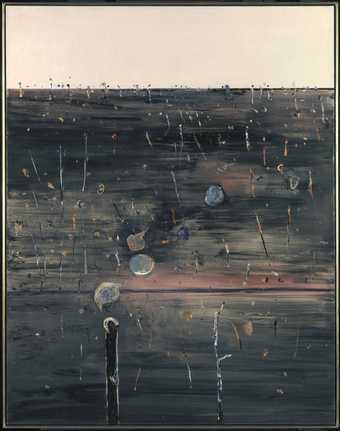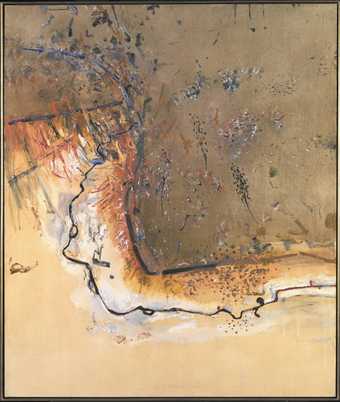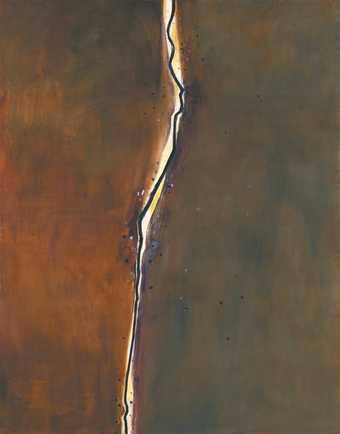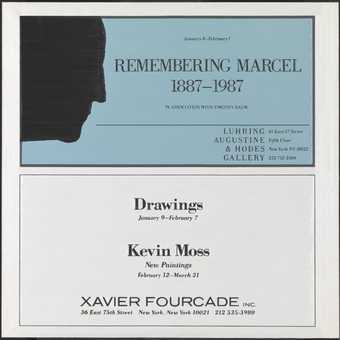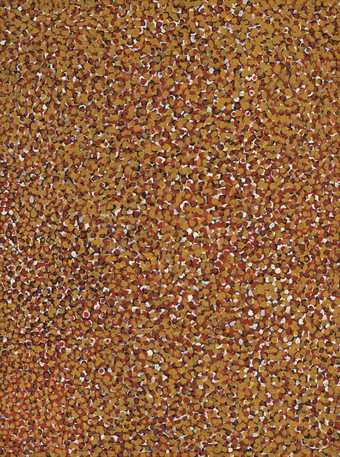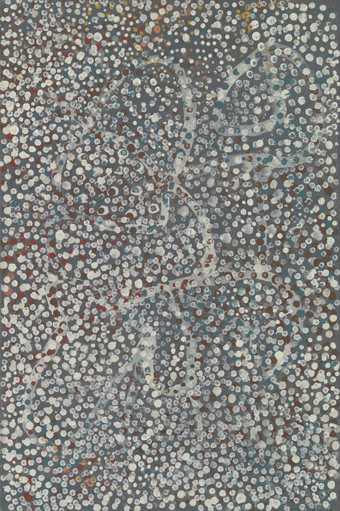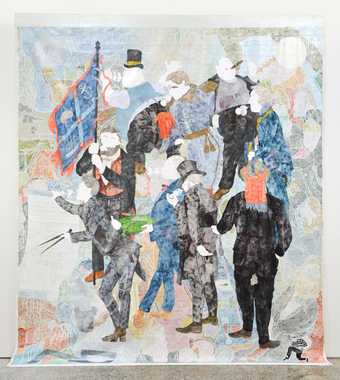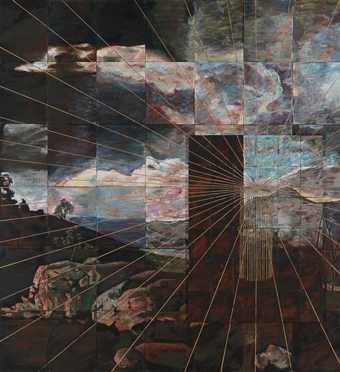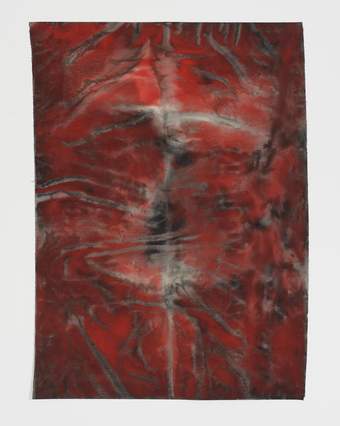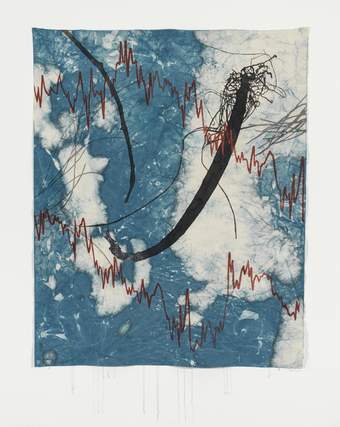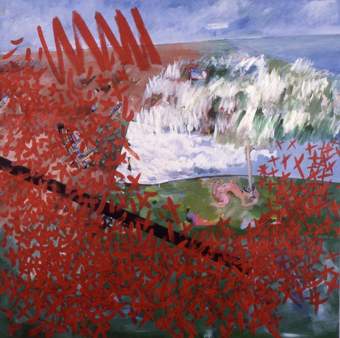
Not on display
- Artist
- Emily Kame Kngwarreye 1910–1996
- Medium
- Acrylic paint on canvas
- Dimensions
- Support: 1269 × 950 mm
frame: 1405 × 1090 × 70 mm - Collection
- Tate
- Acquisition
- Purchased with funds provided by Lady Sarah Atcherley in honour of Simon Mordant 2019
- Reference
- T15134
Summary
Endunga 1990 is an acrylic painting on linen in which the entire surface is covered with a dense agglomeration of dots in cream, brown green and pale orange tones, laid over a more linear underlayer or foundation. Kngwarreye began to paint with acrylic in late 1988, when she was already in her seventies, and created over 3,000 paintings between then and her death in 1996. Prior to this she made batik-based fabric works, starting in 1977 when a workshop was set up as part of women’s adult education courses in her native community in the Alhalkere land of the Utopia region, 270 kilometres north-east of Alice Springs, in the Northern Territory of Australia. As with Kngwarreye’s earlier batik works, in Endunga the underlying lines resemble plants, branches or veins, but they are mostly obscured by small dots, creating a pictorial field akin to that seen in European pointillist paintings. As the title suggests, the painting derives from the fruit, seeds and reedy strands of native ‘endunga’ grass in Alhalkere. The canvas edges are also painted in short brown, black and pale pink stripes which are similar to the body-painting lines used in Anmatyerre women’s ceremonies, in which Kngwarreye was a key elder. They also often indicate rivers and the terrain of the community’s landscape.
Kngwarreye’s paintings are formally abstract, consisting of dots, lines or coloured fields. Her work was inspired by her cultural life as an Anmatyerre elder, and her lifelong custodianship of the women’s Dreaming sites in her clan country of Alhalkere. As with other contemporary Aboriginal art in Australia, Kngwarreye’s work is closely connected with contemporary issues surrounding identity and land right within a post-colonial condition, while also sharing formal affinities with abstract modern art movements.
In paintings such as Endunga, Kngwarreye painted on unstretched linen laid flat on the ground, in a similar manner that she would also make traditional sand paintings for women’s ceremonies in her community. The location of Alhalkere, also known as ‘Alalgura’, is central in Kngwarreye’s imagery. The ‘dots within dots’ style is characteristic of her work, representing the plant seeds that are native to her land, while also seemingly abstract. This is also seen in two other paintings, also in Tate’s collection, Untitled (Alhalkere) 1989 (Tate T15133) and Untitled 1990 (Tate T15135). The artist also chose colours that stem from nature and her community surroundings, often chiming with the seasons. Dots are widely used in Australian aboriginal art, in particular by artists in Papanya Tula, an area in the Western Desert, but Kngwarreye’s dot paintings such as this one are distinctive in their non-figurative composition and lack of direct connection to the creation stories or ‘Dreamings’ commonly found in aboriginal art.
A closer examination of the Alhalkere landscape reveals that Kngwarreye’s paintings are surprisingly accurate depictions of actual surroundings, originating in her deep understanding of the land as a complex link between places and people that contains traces and memories of the past, present and even future, a unique notion of time that indigenous people describe as ‘everywhen’. Her works are therefore simultaneously abstract and representational. In a rare interview in 1990 with Rodney Gooch, a long-time manager of Central Australian Aboriginal Media Association (CAAMA) that facilitated the sales of artworks from the Utopia including hers, Kngwarreye talked about her imagery: ‘Whole lot, that’s whole lot, Awelye (my Dreaming), Arlatyeye (pencil yam), Arkerrthe (mountain devil lizard), Ntange (grass seed), Tingu (Dreamtime pup), Ankerre (emu), Intekwe (favourite food of emus, a small plant), Atnwerle (green bean), and Kame (yam seed). That’s what I paint, whole lot.’ (Translated by Kathleen Petyarre, in M. Boutler 1991, p.61.) In other words, rather than being descriptive of elements of a landscape, her paintings could be understood as encapsulating a totality of the conditions of her identity and life. Throughout her prolific artistic career, Kngwarreye continued to document and interact with her land, and played a seminal role in preserving its integrity in accordance with her ancestral journeys.
Further reading
Margo Neale, Emily Kame Kngwarreye: Alhalkere: Paintings from Utopia, exhibition catalogue, Queensland Art Gallery, Brisbane 1998.
Michael Boulter, The Art of Utopia: A New Direction in Contemporary Aboriginal Art, Sydney 1991.
Sook-Kyung Lee
September 2018
Does this text contain inaccurate information or language that you feel we should improve or change? We would like to hear from you.
Display caption
Kngwarreye’s paintings represent Alhalkere country, where she lived and was a custodian of the land. Her depiction of the physical landscape, including the soil and the air above it, is interwoven with her knowledge of Alhalkere and Anmatyerre Creation Stories. Endunga is a type of grass, whose fruit seeds and reedy strands are evoked here by an underlayer of cream, khaki, and orange dots. Along the edges of this canvas and Untitled (Alhalkere) are short stripes. These are similar to the body-painting lines used in awelye (Anmatyerre women’s ceremonies) and may indicate rivers and other geographical features.
Gallery label, July 2021
Does this text contain inaccurate information or language that you feel we should improve or change? We would like to hear from you.
You might like
-
Fred Williams Burnt Landscape II (Bushfire Series)
1970 -
Fred Williams Dry Creek Bed, Werribee Gorge I
1977 -
Fred Williams Riverbed D
1981 -
Simon Linke Remembering Marcel 1987
1988 -
Gordon Bennett Possession Island (Abstraction)
1991 -
Emily Kame Kngwarreye Untitled (Alhalkere)
1989 -
Emily Kame Kngwarreye Untitled
1990 -
Helen Johnson Bad Debt
2016 -
Helen Johnson Seat of Power
2016 -
Helen Johnson A Feast of Reason and a Flow of Soul
2016 -
Imants Tillers Kangaroo Blank
1988 -
D Harding The Leap/Watershed
2017 -
Judy Watson massacre inlet
1994 -
Judy Watson memory scar, grevillea, mangrove pod (& net)
2020 -
Vivienne Binns The Aftermath and the Ikon of Fear
1984–5

